Home
Camera
Articles FOR SALE
Orders
I Buy / Wants Repairs
Books Adapters 
Kodak Retina 3 BIG C
The Kodak Retina IIIC enjoys the
reputation as one of Kodak's most collectible cameras. Many consider it the
best of all folding 35's.
I don't agree.
Now to be fair about it, or almost fair, the
1959 Retina IIIC is the last of a long line of folding Kodak 35's which began in
1934 and had the honor of introducing Photography to the now standard 35 mm
cartridge. Some people like the IIIC because it was the last and most feature
laden of the line. The IIIC is also the largest, most complicated of the
lot. Like the other Retinas of the late 50's, it has the reputation of
an overly complicated internal construction. Many repairmen refuse to work on
them. By far the IIIC is also the highest priced folding Retina in
today's collector market. In 1996 when the exchange rate was 100 Yen to the dollar,
incredulous US camera dealers happily sold perfect Mint IIIC's to the Japanese market
for $1000.
The IIIC's claim to fame is its best (for
Retina) projected line parallax corrected finder with built in framelines for its
limited lineup of 35, 50 and 80 lenses. Alas, a M Leica it
ain't. All frames are visible all the time, giving a cluttered feeling.
Worse, the finder or rangefinder spot are not all that bright. It also
has a tendency to collect flare over the years. While the the IIIC's
finder great looks compared to the squinty little finders of previous Retinas, it
palls in comparison to its contemporaries from Leica, Nikon, or
Canon.
Of course it could be argued that comparing the IIIC isn't fair,
since the IIIC sold for considerably less than the Leica IIIf or M3. Well, perhaps
when they were new. Today a Retina IIIC is likely to sell for
in Leica IIIf Black Dial territory
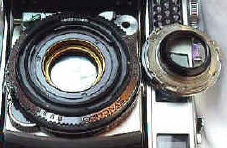
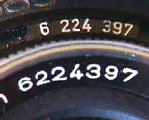
This pic shows shows the front element
of the 50/2 lens removed. Front element? Yep, that's right. The
Retina doesn't feature true interchangeable lenses, rather true interchangeable FRONT
elements. It makes for a more compact camera. It also makes for some optical
compromises and some ridiculously LARGE SLOW wide and tele lenses.
To remove the a front lens component, all you do is rotate it counter clock-wise. It
clicks right in or out. IMPORTANT: Notice the two sets of serial
numbers. These MUST match for you to have a properly working 50 mm lens.
IF they don't, some SOB has switched them and the camera is useless until you have a
repairman install a new matched pair of front and back elements into the camera.
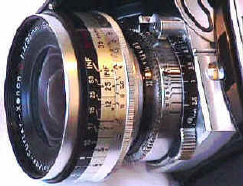
What's this? Would you believe a 35mm
wide-angle? Note its incredible size, for a slow 35/4 optic!! Even
worse, this baby is NOT rangefinder coupled!! You have to first focus the 50
mm rangefinder, get a footage figure, then transfer that figure to the wide or tele
lens! Are you really desperate enough for lens choices to tolerate this? I
hope not.
The next issue is compact size.
The entire reason for a folder is SIZE. Yet, as the pics below show,
the IIIC is larger than its contemporary Leica IIIf with collapsed 50/2 Summitar.
It is MUCH larger than a Leica IIIf with a 35 wide angle! What's going on
here? With the standard 50/2 lens, the IIIC weighs 1 lb. 17 oz, Vs 1 lb. 16 oz
for the Leica! Small yes, but why not smaller??
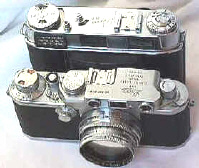

The next thing I don't like about it, or most
of the later Retinas, is their STRANGE controls.
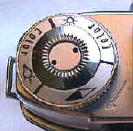
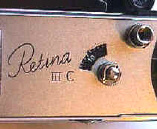

Left to right. OK, the rewind knob is
not so strange. But what about that strange manually setting film counter?
You have to push down on that little button beside the counter, while you push that button
on the backside of the top plate (visible barely from the top view). The counter
counts backwards, showing you how many shots you have left. This is a late IIIC with
the 3200 ASA dial setting. Also notice the arrow direction next to the rewind knob,
also a late IIIC feature. The meter is NOT coupled, and simply shows the LVS
value to set the camera too. LVS value? It's a pain, set up for idiots too
lazy to learn f/stops and shutter speeds.
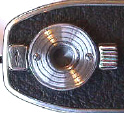
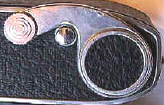
We are now looking at the bottom of the
camera. To open the back, turn that in the direction of that little arrow
around the tripod socket. Underneath you will find not an Easter Egg, but a little
button which you push to open the back. To the left is the bottom mounted
film advance and shutter cocking lever. It's actually convenient, but takes some
getting used to. That button is the film rewind button, but also unlocks the film
advance. When you get to the last exposure, the shutter and advance lock until the
film counter is set back. You do that with the above mention methods, plus pushing
in on the film rewind button. Note the soft aluminum advance lever which scars
so easily.

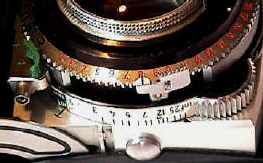
OK folks, words may fail me here in this
gadgeteer's paradise, but I will give it a shot. These two pics show the
lens/shutter assembly from the top and bottom views.
Left pic, working down to up.
Notice that large button near the bottom edge of the picture, and another one in the other
picture. Those are the locking buttons for the lens. To retract the lens 1)
make sure the lens in at the infinity focus 2) push those little buttons in 3) close the
door. Still on the left pic, work up and notice the focusing scale and the depth of
field indicator. Above that are the shutter speeds 1 to 1/500 and the f/stops 2 to
22.
Right pic shows the focusing lever on
the right corner of the photo. It has to be in this infinity position for the camera
to close. Above that is the loathed LVS system. It locks the shutter
speeds and f/stops together at the pre-selected light value, so they move together--when
you move to a larger f/stop, the shutter speed automatically shifts to a higher speed too.
This system may be fine while you are taking pics in the same conditions, but as light
conditions change and you want to adjust exposure, this extra step really becomes a
nuisance. If you plan to shoot your Big C, I suggest removing that LVS
lock. To the left notice the PC connection. It thoughtfully aims the PC
connector straight down so it can fall of more quickly and easily.
The LVS system locks the shutter and
aperture into combination which moves together. Thus changing one
automatically changes the other. The LVS scale and lock are not so conveniently
found on the bottom side of the shutter. Also note the focusing lever, which MUST
be at the infinity position for the lens to collapse.
Better 35 folders? I personally
find both the Zeiss Contessa and the Voigtlander Vitessa much better made and well
finished cameras.
Compact?
The Zeiss Contessa has the Retina IIIC beat in compactness, weight, finer finish,
construction quality, and price. Contessas currently sell for about half of the
IIIC price. So why get a IIIC?
While the Retina IIIC is not
on my list of favorite cameras, it does have admirers, visit them at http://www.netins.net/showcase/crye/retina.htm
and http://user.itl.net/~kypfer/intro.htm.
I will agree that the IIIC is a
fine picture taker. The problem is that there are far better choices....especially
for the money.
Revised:
November 26, 2003
. Copyright � 1998-2002
Stephen Gandy. All rights reserved. This means you may NOT
copy and re-use the text or the pictures in ANY other internet or printed
publication of ANY kind. Information in this document is subject to change
without notice. Other products and companies referred to herein are
trademarks or registered trademarks of their respective companies or mark
holders.












